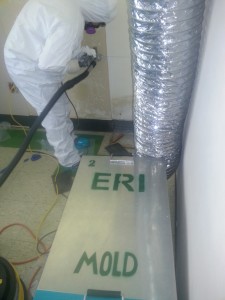
Despite the warm, dry conditions of summer, mold problems can persist in moisture-prone areas. Photo: Environmental Remedies, Inc. (2016)
Mold is a common household problem during the winter, when the moist, rainy weather creates ideal conditions for fungi to flourish. While the arrival of summer tends to reverse these conditions, in some residences, mold is nonetheless a year-round problem. For example, if your home is poorly ventilated or situated in a humid or heavily shaded location (i.e. coastal or dense forest), the warm summer climate may do little to mitigate mold, which means you’ll need to take proactive measures to combat it.
The first step is determining your home’s humidity levels, which you can do with a hygrometer, an inexpensive gauge that measures relative humidity (RH). During the summer, an interior RH level of 60 percent or below is usually adequate, but if your home’s conditions favor moisture, maintaining this level can be challenging. Start with the basics: maximize ventilation and air circulation by opening some windows or running your air conditioner. To further supplement these moisture-fighting measures, consider purchasing a dehumidifier, which manually removes moisture from the air. Additionally, make sure your kitchen, bathroom and laundry room are well-ventilated, and always run exhaust fans when these areas are in use.
While these proactive steps will help combat mold problems, sometimes more intensive measures are needed. This is especially true in instances when mold is hidden, whether inside of a wall or beneath flooring. In fact, mold in wall insulation or moisture barriers can remain dormant throughout the summer, only to revive when favorable conditions return.
Due to the potentially surreptitious nature of a mold problem, you need be aware of non-visual indications of its presence. One is its distinct odor, which is emanated by the gasses it diffuses. Another potential sign is health-related: for those with respiratory or immune system problems, mold can trigger allergic reactions and other symptoms, so if these persist in the summer, you should consider mold as a possible cause.
If you suspect you have a mold problem but are unable to pinpoint the source, it’s a good idea to call a professional. A mold abatement specialist will gather air samples and use technology like thermal imaging to detect mold in hidden areas. In addition to locating hidden mold, a professional will detect and deal with the source of the issue so it won’t return.
To find a Diamond Certified mold abatement professional, visit www.diamondcertified.info.
